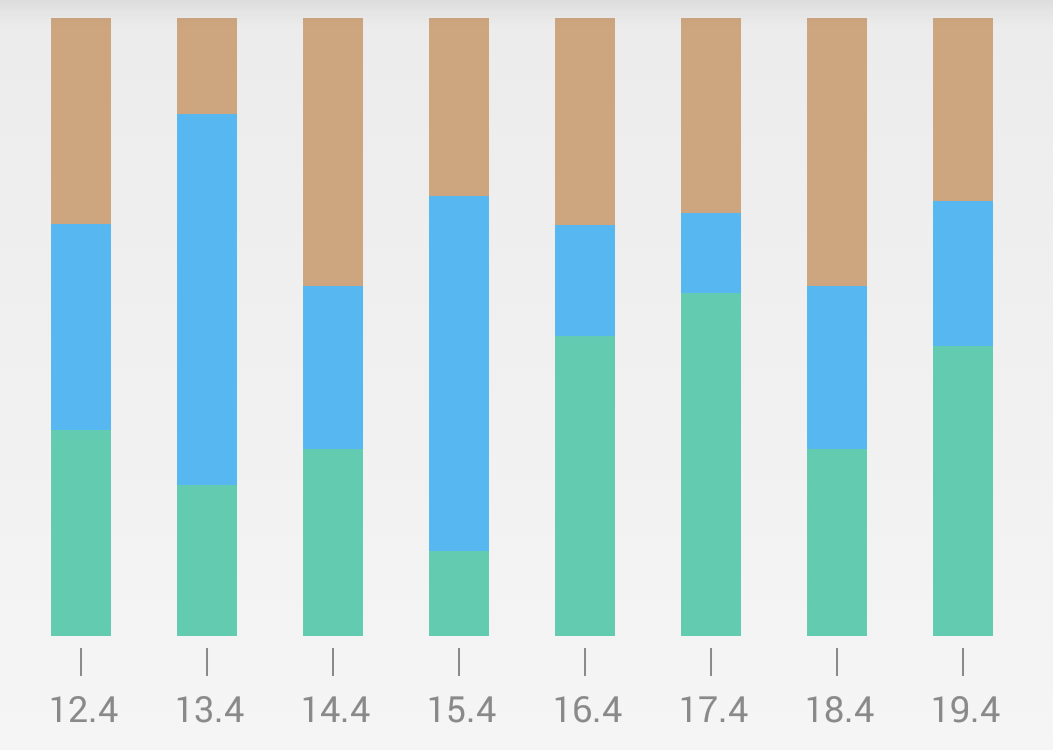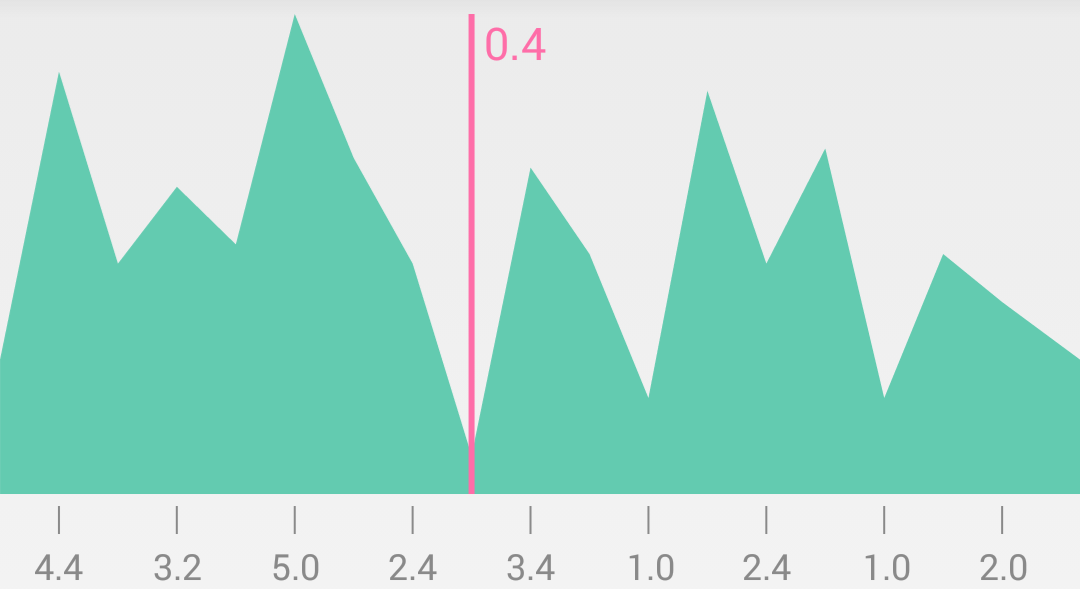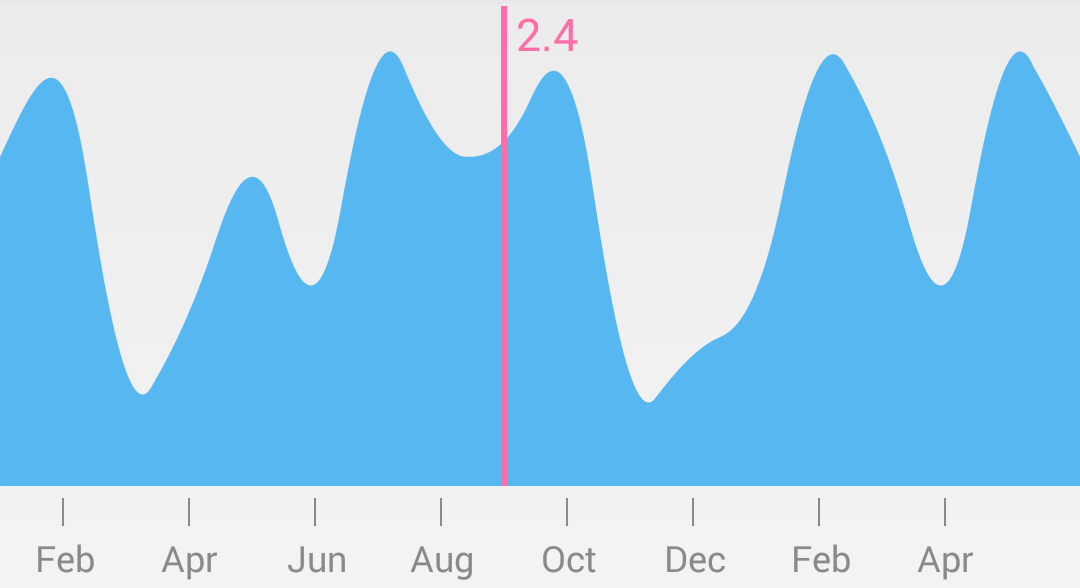EazeGraph is an Android library for creating beautiful and fancy charts. Its main goal was to create a lighweight library which is easy to use and highly customizeable with an "up-to-date"-look.
Currently 4 different chart types are available, which can be viewed below.
IMPORTANT:
This library is not intented for "mathematical" purposes like "achartengine" or "androidplot". It is intented to have a beautiful visual presentation of "user related"-data where only one value is provided and the rest is calculated dynamically.
So for example it's not possible to push 2D-values in the LineChart and let them plot just like in our beloved math lessons.
If you want such functionality either you use one of the libraries I named before or you wait some time until I finished a "mathematical plotting"-chart ;)
Currently BarCharts only support positive values. I will provide this functionality later.
Your Android application should use Android API Level 9 or higher in order to use this library!!!





Examples on how to correctly use these charts are either below or you can view the source of the sample app I provided.
If you want to see the library in action, just download the sample app from the PlayStore: https://play.google.com/store/apps/details?id=org.eazegraph.app
Add in your android app project folder in the 'build.gradle' under dependencies:
dependencies {
compile 'com.github.blackfizz:eazegraph:1.2.2@aar'
compile 'com.nineoldandroids:library:2.4.0'
}Or if you want to use my new lightweight library without any interaction some new features then download this:
dependencies {
compile 'com.github.blackfizz:eazegraph:1.2.5l@aar'
compile 'com.nineoldandroids:library:2.4.0'
}The library uses the nineoldandroids support library to support the animations on older devices.
If you already use this library, you don't have to include it.
That's it. now you are ready to use the library!
Before you use the project please prepare all required settings in a configuration file.
There is an example file called gradle.properties.example contained in the repository
which you can copy and rename to gradle.properties.
<org.eazegraph.lib.charts.BarChart
xmlns:app="http://schemas.android.com/apk/res-auto"
android:id="@+id/barchart"
android:layout_width="match_parent"
android:layout_height="256dp"
android:padding="10dp"
app:egFixedBarWidth="true"
app:egBarWidth="20dp"
app:egLegendHeight="40dp"/>BarChart mBarChart = (BarChart) findViewById(R.id.barchart);
mBarChart.addBar(new BarModel(2.3f, 0xFF123456));
mBarChart.addBar(new BarModel(2.f, 0xFF343456));
mBarChart.addBar(new BarModel(3.3f, 0xFF563456));
mBarChart.addBar(new BarModel(1.1f, 0xFF873F56));
mBarChart.addBar(new BarModel(2.7f, 0xFF56B7F1));
mBarChart.addBar(new BarModel(2.f, 0xFF343456));
mBarChart.addBar(new BarModel(0.4f, 0xFF1FF4AC));
mBarChart.addBar(new BarModel(4.f, 0xFF1BA4E6));
mBarChart.startAnimation();<org.eazegraph.lib.charts.StackedBarChart
xmlns:app="http://schemas.android.com/apk/res-auto"
android:id="@+id/stackedbarchart"
android:layout_width="match_parent"
android:layout_height="256dp"
android:padding="10dp"
app:egFixedBarWidth="true"
app:egBarWidth="20dp"
app:egLegendHeight="40dp"/>StackedBarChart mStackedBarChart = (StackedBarChart) findViewById(R.id.stackedbarchart);
StackedBarModel s1 = new StackedBarModel("12.4");
s1.addBar(new BarModel(2.3f, 0xFF63CBB0));
s1.addBar(new BarModel(2.3f, 0xFF56B7F1));
s1.addBar(new BarModel(2.3f, 0xFFCDA67F));
StackedBarModel s2 = new StackedBarModel("13.4");
s2.addBar(new BarModel(1.1f, 0xFF63CBB0));
s2.addBar(new BarModel(2.7f, 0xFF56B7F1));
s2.addBar(new BarModel(0.7f, 0xFFCDA67F));
StackedBarModel s3 = new StackedBarModel("14.4");
s3.addBar(new BarModel(2.3f, 0xFF63CBB0));
s3.addBar(new BarModel(2.f, 0xFF56B7F1));
s3.addBar(new BarModel(3.3f, 0xFFCDA67F));
StackedBarModel s4 = new StackedBarModel("15.4");
s4.addBar(new BarModel(1.f, 0xFF63CBB0));
s4.addBar(new BarModel(4.2f, 0xFF56B7F1));
s4.addBar(new BarModel(2.1f, 0xFFCDA67F));
mStackedBarChart.addBar(s1);
mStackedBarChart.addBar(s2);
mStackedBarChart.addBar(s3);
mStackedBarChart.addBar(s4);
mStackedBarChart.startAnimation(); <org.eazegraph.lib.charts.PieChart
xmlns:app="http://schemas.android.com/apk/res-auto"
android:id="@+id/piechart"
android:layout_width="match_parent"
android:layout_height="300dp"
android:padding="8dp"
app:egLegendTextSize="18sp"
app:egUsePieRotation="true"
app:egValueTextSize="36sp"/>PieChart mPieChart = (PieChart) findViewById(R.id.piechart);
mPieChart.addPieSlice(new PieModel("Freetime", 15, Color.parseColor("#FE6DA8")));
mPieChart.addPieSlice(new PieModel("Sleep", 25, Color.parseColor("#56B7F1")));
mPieChart.addPieSlice(new PieModel("Work", 35, Color.parseColor("#CDA67F")));
mPieChart.addPieSlice(new PieModel("Eating", 9, Color.parseColor("#FED70E")));
mPieChart.startAnimation();<org.eazegraph.lib.charts.ValueLineChart
xmlns:app="http://schemas.android.com/apk/res-auto"
android:id="@+id/cubiclinechart"
android:layout_width="match_parent"
android:layout_height="200dp"
app:egUseCubic="true"
app:egUseOverlapFill="true"
app:egCurveSmoothness="0.4"
app:egIndicatorLineColor="#FE6DA8"
app:egLegendHeight="40dp"
app:egShowStandardValue="true"/>ValueLineChart mCubicValueLineChart = (ValueLineChart) findViewById(R.id.cubiclinechart);
ValueLineSeries series = new ValueLineSeries();
series.setColor(0xFF56B7F1);
series.addPoint(new ValueLinePoint("Jan", 2.4f));
series.addPoint(new ValueLinePoint("Feb", 3.4f));
series.addPoint(new ValueLinePoint("Mar", .4f));
series.addPoint(new ValueLinePoint("Apr", 1.2f));
series.addPoint(new ValueLinePoint("Mai", 2.6f));
series.addPoint(new ValueLinePoint("Jun", 1.0f));
series.addPoint(new ValueLinePoint("Jul", 3.5f));
series.addPoint(new ValueLinePoint("Aug", 2.4f));
series.addPoint(new ValueLinePoint("Sep", 2.4f));
series.addPoint(new ValueLinePoint("Oct", 3.4f));
series.addPoint(new ValueLinePoint("Nov", .4f));
series.addPoint(new ValueLinePoint("Dec", 1.3f));
mCubicValueLineChart.addSeries(series);
mCubicValueLineChart.startAnimation();1.2.2
1.2.1
1.2.0
I had those things on my HDD for some months and never had the time to release it or to polish it.
I think this should be stable and release it for you guys. I know there are some open issues and I really want to fix those error or implement new features,
but I am not able to do anything of those as I am completely busy with my university and work.
In addition to that I made a lightweight variant of the library for my work which can be downloaded as the version 1.2.5l.
This removes every physical interaction with the library and only provides displaying functionality. Most of the work went into the
ValueLineChart as it now has a X-Grid with 4 stages. I don't know when I have some time again to implement new stuff or fix bugs,
but i hope it won't be so long as my last absence. Happy using :)
1.1.14
1.1.13
1.1.12
egUseDynamicScaling and the scaling factor can be set with egScalingFactor which should be between 0 and 1 (When only high values are given, the chart scales them down to achieve a better presentation without any loss of information)1.1.10
egStandardValueIndicatorStroke and egStandardValueColor attributes and created an extra StandardValue class, which contains all these information. Doing this enabled the support for multiple StandardValuesBarModel, PieModel, ValueLinePoint1.1.9
BaseChart class and only calls methods which can be overwritten in the child graph classes. This reduced many redundancies and the layout generation of the views is handled in one location.1.1.8
egActivateIndicatorShadow was not usableegActivateIndicatorShadow)1.1.7
egInnerValueUnit ValueLineChart: egIndicatorTextUnit)egIndicatorColor and made separate attributes for indicator line and text (egIndicatorLineColor and egIndicatorTextColor)egActivateIndicatorShadow, egIndicatorShadowStrength, egIndicatorShadowColor)1.1.6
1.1.4
1.1.3
1.1.2
1.1.1
1.1.0
1.0.14
1.0.10
1.0.9
1.0.8
1.0.7
1.0.6
1.0.5
1.0.4
1.0.1
1.0.0
I would love to see people contributing to this project. So just go ahead. If you think you did something amazing and your feature should be implemented in this library, make a pull request! Do not hesitate.
Apps using EazeGraph:
https://play.google.com/store/apps/details?id=com.yazio.android
Copyright (C) 2015 Paul Cech
Licensed under the Apache License, Version 2.0 (the "License");
you may not use this file except in compliance with the License.
You may obtain a copy of the License at
http://www.apache.org/licenses/LICENSE-2.0
Unless required by applicable law or agreed to in writing, software
distributed under the License is distributed on an "AS IS" BASIS,
WITHOUT WARRANTIES OR CONDITIONS OF ANY KIND, either express or implied.
See the License for the specific language governing permissions and
limitations under the License.